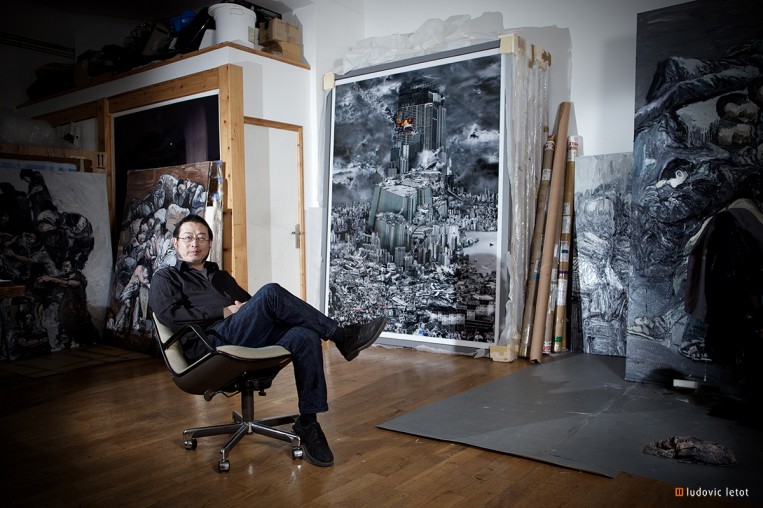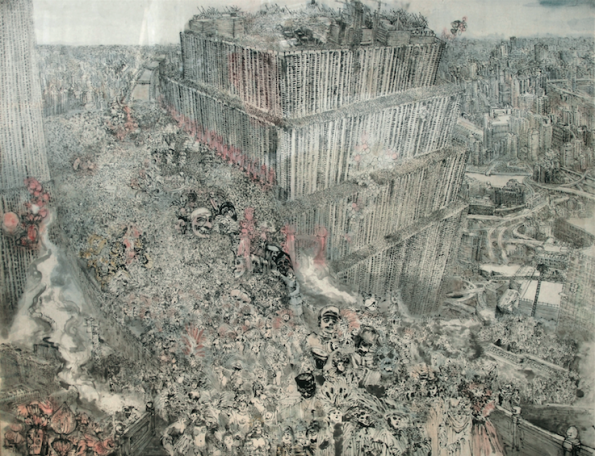Asian Spring


Du Zhenjun’s interactive multimedia installation, Presumption (2000), observes, as do many contemporary works, that the history to which we belong is not subject to the passage of time, but to the awareness of time. It traces the growing consciousness that our visual records belong less to what might be called a history of humanity - as if it were only before or behind us - than to a story fabricated by each of us for ourselves and for others.
The installation is based on a concept of spatial separation which is, in a way, the part of the work that both eludes us and, paradoxically, connects us. When the viewer stands on the sensors, they cannot physically approach the image, nor can they move elsewhere. In a sense, they are obliged to occupy this exact position if they want to interact with the images and the installation. Moreover, they are forced to view the double triptych of images in the company of the other visitors. They must position themselves in the space with the others, stand in plain sight, and enter into this improvised and unpredictable choreography.
Subjected to the whims of the other visitors as well as to the game of images, the viewer cannot help but become agitated by the absence of another person (or, in this case, the absence of the image of another person) if no-one else enters into the installation. The black, empty screen and the sensors that have been abandoned by the other visitors become desolate places where absence and emptiness are transformed into gaps where something could take place, where something happens in spite of everything, but without the viewer being able to see it.
It is in the very blackness of the screen that signs, symbols, or words become something new, almost imperceptible, floating, caught in the process of signification. Here, they can accumulate other meanings.
Zhenjun’s installation is based on this ambivalence of movement and static, on the accumulation of meanings and the endless possibilities offered by filmed material to freeze such meanings into static images.
If the images that Du gives us belong to video – or to cinema, that is to say, filmed sequences -, they function in the mode of the “photographic snapshot”: the freeze frame, an unpredictable and unrepeatable image that immobilises the action. Paradoxically, the freeze frame also sets off a flow of images that it interrupts almost immediately. The image received sporadically retraces the path of a faltering and distant recollection; it reconstructs not only a story - the story of human consciousness - but also the history of memory, of that part of the momentarily abandoned sign that each person retains in his or her own way.
The photographer-spectator, therefore, is no longer able to choose precisely what they will “photograph,” as they may be as surprised by the image as by the black that precedes or follows it. The more the sequences shown on the three screens move and shift, the less the photographer-spectator will be able to fix the shot.
It is in this hollow created by the absence of visual matter that consciousness takes shape. It is in the void, which is at once full of the absence of images and of the abundance of possible images, that the creative exchange takes place. This is an exchange that happens at several levels: the intimacy of the thermal baths is confronted by a public gaze; the game of movement becomes a piece of choreography in which the participants on either side try to come into contact with one another; and the choice of black and white images introduces the notion of time and temporal shifts, as well as the question of the physical nature of memory.
The encounters are inscribed in this space, the black, the meeting place of what is offered and what is seen. Here, this free-floating sign refers to a collective recollection - the memory of remembrance.
Between the sensors and the screens, a space separates the place of performance from the place of observation; it is situated between the filmed material and the spectators. The six pairs of screens and sensors face each other: the movement of the bathers on the screens responds to that of the spectators. The event is not, therefore, confined to the screen. Rather, it is simultaneously separate from and intimately connected to the individual existences of the spectators. The impression of isolation persists in this enclosed space where nothing happens visually except that which takes place in the imagination. The feeling of having passed from one private life to another, from that of the bathers to your own, gives the black screens the special status of a mediating space where the encounter can unfold.
The gazes - those of the bathers and those of the spectators - meet and are lost in the darkness that precedes and follows the image, in this blind intermediary space that is the true site of the event.
While the bathers try to achieve the ideal distance between themselves - and through the three screens on which they intermittently appear - the spectators also search for a balance between the elusive images and their own bodies swaying on the sensors.
The intimacy of these men who bathe together also leads the viewer to believe that it will be difficult to enter further into the image. A certain distance separates the spectators from both the bathers and from one another. This distance is necessary in order to make the gaze and the consciousness reach out for what they seek. Each space of separation is perceived differently: the first and third are physical distance, while the second - that between the screens and the sensors - is made up of time and matter. It is in this space that the interactions take place, that consciousness can become collective and that the sign takes on a new meaning.
The lower parts of the bathers are slowed down by the pressure of the water, and the hesitant feet of the spectators belong to the same choreography. They are of one body, part of which exists inside the screen, and part outside. The way in which the movement of the lower parts of the spectators’ bodies can move the upper parts of the bodies of the bathers suggests the formation of a single consciousness. This consciousness resides in what could be called the memory of remembrance, this collective space that connects us to others, and that memory aids - whether filmed material or photography - try to retain.
It is because the image is in black and white that it is somehow dispossessed of time and space and rendered neutral, becoming an image to be shared collectively. Despite this, however, it remains strangely elusive.
The memory of remembrance has this black and white quality. It is not exactly the colour that you remember, but rather the colour that remains after years of attentive collective listening. This is undoubtedly how part of our history is made, and it is the memory of remembrance that forms the hidden thread by which everyone is discreetly joined.
It is not necessary to understand the narrative framework of this image, which is too complex, nor is it important to determine its origin, as it does not come from any specific place. Rather, it is merely the survival of a sensation experienced by each of us many times over many years. Zhenjun’s installation presents us with these men who move around the thermal baths - they are Yugoslav prisoners of war -, but it is something else that the black and white matter transmits to us here in the west, because it is similar to scenes shot mentally elsewhere. We are transported to the concentration camps of the Second World War, despite the lack of this precise type of image anywhere in the archives of that war. It is this collective memory that we immediately read on the screens.
The elderly men in the footage evoke scenes that were never filmed and thus never seen from that human catastrophe that has haunted us for some five or six decades. That this video comes from very far away only accentuates the strange sensation that we feel; it is the voiceless quality of the images that leads us to this memory. This black and white footage is nothing but the lost memory of remembrance, a shared haunting, imagined together by the community but never seen in reality.
In retrospect it is quite surprising, and perhaps even terrible, to think that images filmed elsewhere and in circumstances about which we know very little provoke in us this collective recollection. They transport us to a scene that we are prepared to recognize, despite everything, and which gives way to an unusual kind of collective emotion and recognition.
The equipment thus sets up what could be called a floating sign: the black image belongs to a place and time that is seemingly indeterminate, and the meaning it conveys is blurred and uncertain. Without a fixed sense of belonging, it defines itself through the encounter.
In this way, Zhenjun’s work is representative of a change that, on the one hand, affects the way in which an artistic work is constructed. On the other, it challenges the viewers in the way that they read the uncertain messages, and thus apprehend the world.